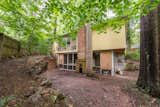College View Home
5 more photos
Details
Credits
From Cook Architecture
College View Home is an extensive and detailed restoration and renovation of an original 1951 Charles Goodman and Associates-designed house, located in the historic Hammond Wood neighborhood of Silver Spring, MD, and completed in 2022. The neighborhood is a community of 56 mid-century modern homes built in 1949-1950 and was featured in Progressive Architecture in May 1952. Exterior renovations include: installation of all new siding, rebuilding of the 1951 Goodman-style wood windows (in their original configuration), and restoration of original brickwork and stone walls. Interior alterations on the first floor include: an expanded and updated galley-style kitchen with custom Poggenpohl cabinetry, an expanded (restored) living room space, and a reconfigured entrance and storage area (small addition of 40 sq infilling an existing covered patio). Interior alterations on the basement level include: reconfiguration of the existing layout to accommodate two new bedrooms, an enlarged bathroom, and an expanded den/family room. In addition, new landscaping and hardscaping elements have been added to enhance the indoor and outdoor relationships created with large expanses of glass with views of the wooded areas and rolling hills of the surrounding environment.
The project strives to achieve two main goals: first, to restore the original 1951 Charles Goodman exterior design and its original elements as faithfully as possible (historical preservation), and second, to modify and upgrade the interior spaces and elements to accommodate modern living conditions. These two stated goals complement one another—a significant mid-century modern structure is restored not solely as a historical artifact, but as a home that has been upgraded both spatially and materially, and re-emerges for present and future use and occupation.
The renovation project seeks to preserve (and in some instances, augment) three elements of the original 1951 Goodman design: expansive amounts of glass and views to the natural landscape, tactile materials, and open floor plans. These elements serve both the physical and psychological well-being of the occupant, in terms of free-flowing circulation and social interaction, as well as a constant visual and physical connection to the landscape beyond.
Beyond the form, aesthetics and tectonics of the “typical” Charles Goodman residential designs, several common themes emerge: accessible design (from a socioeconomic standpoint), open plan layouts and expansive glass facades (healthy and modern living), usage of standard and prefabricated building materials (economical approach to design and construction), and a connection to the natural landscape in both visual and physical terms (views, materials, colors, simple building forms).
In terms of historical preservation, the lasting communal value of this project perhaps extends far beyond the restoration of this specific Goodman structure. As is the case with many preservation and restoration projects, its true value may be an ability to inspire curiosity and interest in a particular aesthetic or cultural movement—in this case, residential mid-century modernism, exemplified by Charles Goodman house designs. The restored Goodman house serves as a physical and symbolic reminder that “high” or “accessible” architectural design can be achieved at a wide variety of economies and scales.



















